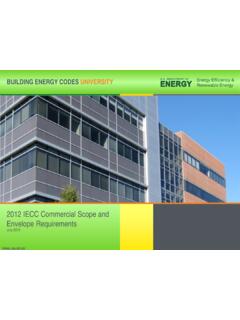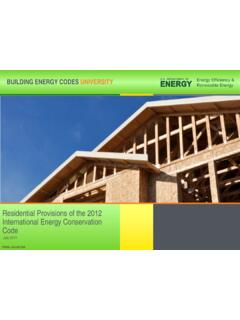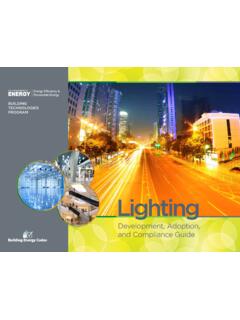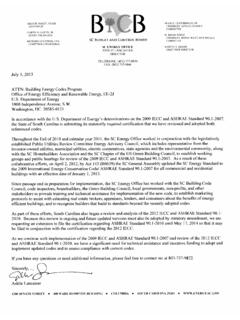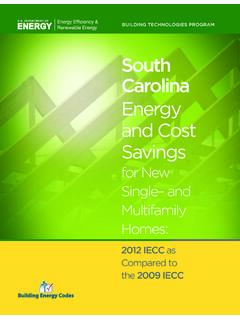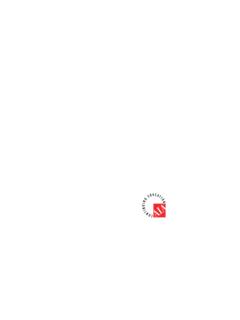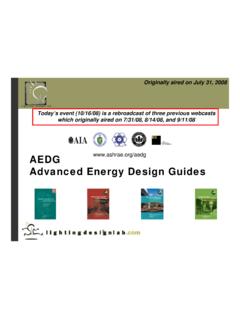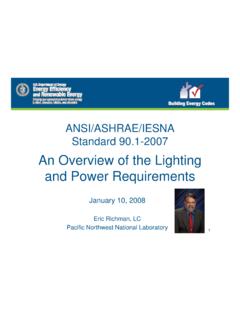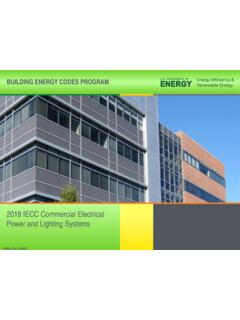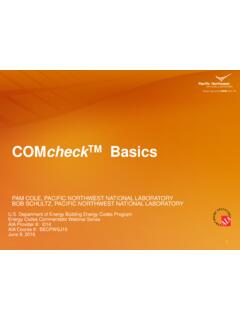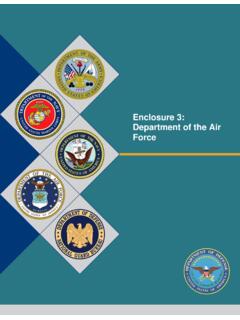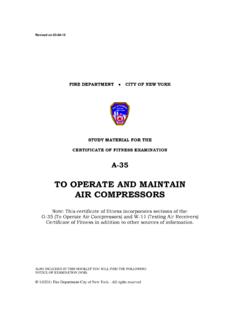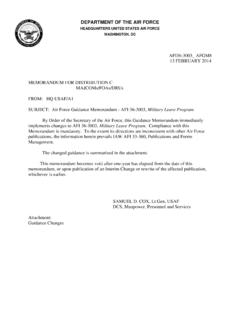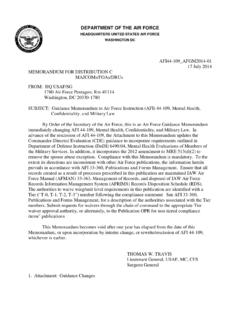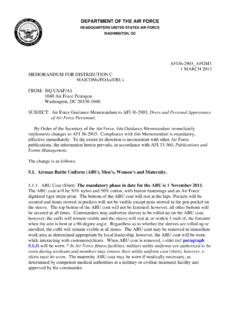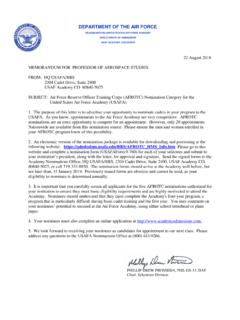Transcription of Meeting the Air Leakage - Energy Codes
1 Meeting the Air LeakageRequirements of the2012 IECCThe department of Energy (DOE) recognizes the enormous potential that exists for improving the Energy efficiency, safety and comfort of newest edition of the International Energy Conservation code (IECC)(2012) sets the bar higher for Energy efficiency, and new air sealing requirements are one of the key new guide is a resource for understanding the new air Leakage requirements in the 2012 IECC and suggestions on how these new measures can be met. It also provides information from Building America s Air Sealing Guide, Best Practices and case studies on homes that are currently Meeting the provisions. The 2012 IECC and a few International Residential code (IRC) requirements are referenced throughout the Leakage GUIDE | BUILDING TECHNOLOGIES PROGRAMB uilding Energy code Resource Guide:Air Leakage GuidePREPARED BYBuilding Energy CodesDOE s Building Energy Codes Program (BECP) is an information resource on national Energy Codes .
2 BECP works with other government agencies, state and local jurisdictions, national code organizations, and industry to promote stronger building Energy Codes and help states adopt, implement, and enforce those 2011 Prepared for the department of Energy under Contract DE-AC05-76 RLO 1830 PNNL-SA-82900 This report was prepared as an account of work sponsored by an agency of the United States Government. Neither the United States Government nor any agency thereof, nor Battelle Memorial Institute, nor any of their employees, makes any warranty, express or implied, or assumes any legal liability or responsibility for the accuracy, completeness, or usefulness of any information, apparatus, product, or process disclosed, or represents that its use would not infringe privately owned rights. Reference herein to any specific commercial product, process, or service by trade name, trademark, manufacturer, or otherwise does not necessarily constitute or imply its endorsement, recommendation, or favoring by the United States Government or any agency thereof, or Battelle Memorial Institute.
3 The views and opinions of authors expressed herein do not necessarily state or reflect those of the United States Government or any agency TECHNOLOGIES PROGRAM | AIR Leakage GUIDE AIR Leakage GUIDE | BUILDING TECHNOLOGIES PROGRAMWHAT S INSIDE1 INTRODUCTION: Basics of Air Leakage ..12 Codes : New code Air Leakage Requirements ..33 PLANNING: Air Sealing Measures and Checklists ..54 TESTING: Requirements .. TESTING: Presenting Results .. VENTILATION: Requirements .. HVAC SIZING: Requirements ..258 CASE STUDIES: Alternative Methods of Construction ..31. Appendix A: References and More Information on Air Sealing ..33 Appendix B: Whole-House Mechanical Ventilation code Note ..35 BUILDING TECHNOLOGIES PROGRAM | AIR Leakage GUIDE AIR Leakage GUIDE | BUILDING TECHNOLOGIES PROGRAM1 Air Leakage control is an important but commonly misunderstood component of the Energy efficient house. Tightening the structure with caulking and sealants has several positive tight house will:>> Have lower heating bills due to less heat loss>> Have fewer drafts and be more comfortable>> Reduce the chance of mold and rot because moisture is less likely to enter and become trapped in cavities>> Have a better performing ventilation system>> Potentially require smaller heating and cooling equipment Leakage is sometimes called infiltration, which is the unintentional or accidental introduction of outside air into a building, typically through cracks in the building envelope and through use of doors for passage.
4 In the summer, infiltration can bring humid outdoor air into the building. Whenever there is infiltration, there is corresponding exfiltration elsewhere in the building. In the winter, this can result in warm, moist indoor air moving into cold envelope cavities. In either case, condensation can occur in the structure, resulting in mold or rot. Infiltration is caused by wind, stack effect, and mechanical equipment in the building (see Figure 1).Wind creates a positive pressure on the windward face and negative pressure on the non-windward (leeward) facing walls, which pulls the air out of the building. Wind causes infiltration on one side of a building and exfiltration on the other. Wind effects can vary by surrounding terrain, shrubs, and trees. INTRODUCTION:Basics of Air LeakageBUILDING TECHNOLOGIES PROGRAM | AIR Leakage GUIDE 2 The stack effect is when warm air moves upward in a building. This happens in summer and winter, but is most pronounced in the winter because indoor-outdoor temperature differences are the greatest.
5 Warm air rises because it s lighter than cold air. So when indoor air is warmer than the outdoor air, it escapes out of the upper levels of the building, through open windows, ventilation openings, or penetrations and cracks in the building envelope. The rising warm air reduces the pressure in the base of the building, forcing cold air to infiltrate through open doors, windows, or other openings. The stack effect basically causes air infiltration on the lower portion of a building and exfiltration on the upper equipment such as fans and blowers causes the movement of air within buildings and through enclosures, which can generate pressure differences. If more air is exhausted from a building than is supplied, a net negative pressure is generated, which can induce unwanted airflow through the building exhaust fans, clothes dryers, built-in vacuum cleaners, dust collection systems, and range hoods all exhaust air from a building. This creates a negative pressure inside the building.
6 If the enclosure is airtight or the exhaust flow rate high, large negative pressures can be 1: Examples of infiltration. Image courtesy: Building Science Corporation, Leakage GUIDE | BUILDING TECHNOLOGIES PROGRAM3 The 2012 IECC has several new requirements for verification of air sealing in new construction and additions. These new requirements apply to new construction, additions, and alterations where adopted by states and local jurisdictions. Furthermore, additional language was added to clarify that where there are conflicts or differences between provisions of the IECC and referenced Codes , the IECC provisions must apply (Section R106, 2012 IECC). Provisions in Referenced Codes and StandardsWhere the extent of the reference to a referenced code or standard includes subject matter that is within the scope of this code , the provisions of this code , as applicable, shall take precedence over the provisions in the referenced code or the building thermal envelope has been required by the Energy code for many years (editions of the IECC).
7 However, in years past the provisions were somewhat vague and only required that areas of potential air Leakage such as joints, seams, and utility penetrations be sealed with a durable material such as caulking, gasketing, or weather stripping. The 2009 IECC required verification of air sealing by either a visual inspection against a detailed checklist or a whole-house pressure test. The 2012 IECC NOW requires all new construction and additions be both visually inspected and pressure tested as mandatory requirements. There have been some slight changes to the visual inspection checklist and ratcheting down of the testing parameters, requiring houses to be much tighter than the previous edition of the code (see Figure 2 and Table 1). Codes :New code Air Leakage RequirementsFor more information on the status of state code adoption, visit TECHNOLOGIES PROGRAM | AIR Leakage GUIDE 4 DEFINITIONSAs defined according to 2012 IECC:BUILDINGAny structure used or intended for supporting or sheltering any use or occupancy, including any mechanical systems, service water heating systems and electric power and lighting systems located on the building site and supporting the THERMAL ENVELOPE The basement walls, exterior walls, floor, roof, and any other building elements that enclose conditioned space or provide a boundary between conditioned space and exempt or unconditioned 2: Climate zones (by county) for the 2012 IECC Climate Zone2009 IECC2012 IECC1 - 2< 7 ACH<_5 ACH @ 50 pascals3 - 8< 7 ACH @ 50 pascals<_3 ACH @ 50 pascalsTable 1: 2009 vs.
8 2012 IECC Comparisons Air Leakage (Mandatory)The building thermal envelope shall be constructed to limit air Leakage in accordance with the requirements of Sections through Leakage Map GraphicAll of Alaska in Zone 7except for the following buroughs in Zone 8: Bethel Northwest Arctic Dellingham Southeast Fairbanks Fairbanks Wade Hampton Nome Yukon-Koyukuk North Slope Zone 1 includes: Hawaii Guam Puerto Rico Virgin IslandsAIR Leakage GUIDE | BUILDING TECHNOLOGIES PROGRAM5 The 2012 IECC provides a comprehensive list of components that must be sealed and inspected. However, unless the components are installed properly, passing the inspection and Meeting the tested air Leakage rate requirements may not be achievable without rebuilding some construction assemblies (such as gypsum board) that were previously installed. A good example is the air barrier between the ceiling (unconditioned attic) and conditioned space (living area). Since air Leakage paths are driven by the fact that warm air rises, the attic is the largest area (square footage) of potential heat loss.
9 Areas in the ceiling that might not have been sealed properly could include recessed cans, wires, pipes, attic access panels, drop down stair or knee wall doors and more. Figure 3 is a picture taken with an infrared camera illustrating where the temperature difference is and potential heat loss. The reds and purples indicate higher heat loss 3: Air Leakage Test Results PLANNING:Air Sealing Measures and ChecklistsCeiling PlaneRecessed CanBUILDING TECHNOLOGIES PROGRAM | AIR Leakage GUIDE InstallationThe components of the building thermal envelope as listed in Table shall be installed in accordance with the manufacturer s instructions and the criteria listed in Table , as applicable to the method of construction. Where required by the code official an approved third party shall inspect all components and verify compliance. The IECC s checklist covers not only air barriers but proper installation of insulation and other elements. In Table , items that are directly related to air Leakage and proper air barriers are highlighted in though the IECC checklist lists 14 specific components that are directly related to air barriers, more attention must be focused on all areas that have potential for air Leakage .
10 A good understanding of building science can facilitate proper air sealing. For example, Building America research identifies 19 key areas where air sealing can improve a home s Energy efficiency, comfort, and building air sealing trouble spots are shown in Figure 4on page 8 and listed in the following table. Several of these trouble spots are described in more detail as highlighted in the Building America Air Sealing Checklist. Additional information on other trouble spots and other building science information can be found in the Building America Best Practices guides and Air Leakage guide available for free download at , contractors, and/or designers should develop an air sealing strategy beginning with reviewing the building plans and identifying potential areas of air Leakage . These checklists can be used to help identify the areas. The strategy also needs to include the types of materials that will be used to create an air barrier and seal the building envelope. The IECC does not identify specific products that must be used to create air barriers and seal the building envelope, but does require that the materials allow for expansion and defined according to 2012 IECC:AIR BARRIERM aterial(s) assembled and joined together to provide a barrier to air Leakage through the building envelope.
